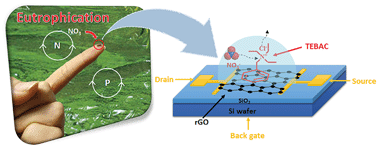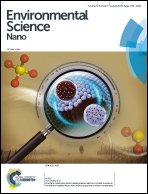Real-time and selective detection of nitrates in water using graphene-based field-effect transistor sensors†
Abstract
Nitrate, the main form of dissolved nitrogen, is one of the key factors causing water eutrophication. Conventional detection methods are unsuitable for real-time and in situ monitoring of nitrates because they need chemical reagents for sensing and are time-consuming. Here we report a novel nitrate sensor based on a field-effect transistor (FET) device. With reduced graphene oxide (rGO) nanosheets as the FET channel material, the sensor uses benzyltriethylammonium chloride (TEBAC) as a capture probe which has been modified on the rGO surface. The rGO/TEBAC sensor exhibits an ultra-low detection limit of 1.1 μg L−1 NO3-N with a rapid response within 2–7 s, which is superior to that of most commonly used sensors and far lower than the threshold concentration of total nitrogen (0.3 mg L−1) for water eutrophication. This simple and miniaturized sensor also shows high selectivity over other anions such as Cl−, SO42− and CO32−. Our study provides a new strategy for rapid, sensitive, and selective detection of nitrates, which is promising for real-time and in situ water quality monitoring.



 Please wait while we load your content...
Please wait while we load your content...